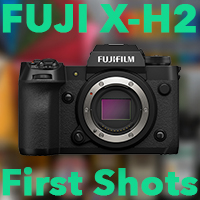Fujifilm X-H2 First Shots: How’s the image quality from this 40MP APS-C camera?
posted Tuesday, September 27, 2022 at 12:00 PM EST
Click here to browse our Fujifilm X-H2 First Shots

It's here! After some brief hands-on time with a couple of prototype samples in New York City, our production-level review sample of the new Fujifilm X-H2 is here and in the lab for testing. I've already started doing some shooting out in the field with this new 40MP X-Trans camera -- so be on the lookout for an updated gallery soon -- but I have just returned from our testing lab for our classic First Shots series of sample images. Time to see how this high-resolution APS-C camera looks across its full ISO range!
Though physically identical to the earlier Fuji X-H2S in terms of its design, this "non-S" version opts for a completely different sensor. The X-H2 uses an all-new 40.2-megapixel X-Trans CMOS HR sensor, making it currently the highest-resolution APS-C camera on the market. The X-H2S, meanwhile, opts for a similar 26.1MP resolution as most of the rest of Fuji's current-generation X Series cameras, like the X-T4 or X100V, except it uses a high-speed stacked design for increased performance. The X-H2 also uses the same new-general X Processor 5 imaging processor, giving the camera a largely similar array of features as its high-speed sibling.

However, the 40MP sensor in the X-H2 gives it a slightly different ISO range, with a different base ISO than the X-H2S. Base sensitivity here is ISO 125 with extended low ISOs doing down to ISO 64. The maximum native ISO is the same as the X-H2S, at ISO 12,800, along with expanded high sensitivities up to ISO 51,200. The X-H2 also has another cool trick, one not shared with the X-H2S: Pixel Shift Multi-Shot mode. Like the medium-format GFX cameras with IBIS, the X-H2 can utilize its in-body image stabilization system to create higher-resolution composite images. In the case of X-H2, the camera can be used to create 160-megapixel still images. The camera captures 20 individual frames, moving the sensor by half a pixel each time, and then you create the composite image off-camera using Fuji's Pixel Shift Combiner desktop software.
As usual for our First Shots series of sample images, we have two series of RAW+JPEG pairs. One with the camera's default level of in-camera JPEG noise reduction processing (files labeled NR5D in this case) and then a set with the camera's lowest level of noise reduction applied. The X-H2 doesn't allow us to turn it off completely, but NR1-labeled images are with the camera's lowest possible NR setting.

We've also shot an ISO series with the new 160MP Pixel-Shift Multi-Shot mode, however the Fujifilm Pixel Shift Combiner desktop software has not yet been updated to work with the raw files from the X-H2. We reached out to Fujifilm to inquire about a new version of the compositing software, and we will update our Samples Page with these high-res sample images as soon as we can.
In the meantime, if you're curious to see how the 40MP X-H2 looks across its full ISO range, head over to our Fuji X-H2 Samples Page for our ISO series of test images. And, if you would like to compare these images side-by-side with all the other cameras we've lab-tested over the years, head over to our handy Comparometer tool.